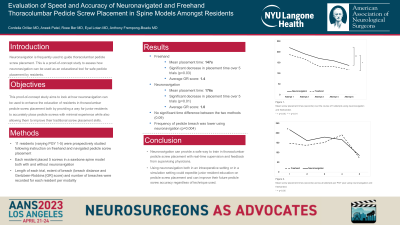Evaluation of Speed and Accuracy of Neuronavigated and Freehand Thoracolumbar Pedicle Screw Placement in Spine Models Amongst Residents
Friday, April 21, 2023


Cordelia Orillac, MD (she/her/hers)
Resident
NYU Langone Health
New York, New York, United States
ePoster Presenter(s)
Introduction: Neuronavigation is frequently used to guide thoracolumbar pedicle screw placement. This is a proof-of-concept study to assess how neuronavigation can be used as an educational tool for safe pedicle placement by residents.
Methods: Sawbone spine models were used for thoracolumbar pedicle screw placements and half were registered with the neuronavigation system. Residents each had the opportunity to place either thoracic or lumbar pedicle screws in the spine models, placing five screws using neuronavigation and another five screws using traditional free-hand methods. Residents were randomly assigned to either start with neuronavigated screw placement or the free-hand method. The residents were timed for the completion of each pedicle screw. An intraoperative computed tomography (CT) scan of each spine model was taken and evaluated blindly by a neuroradiologist to evaluate the accuracy of screw placement using the Gertzbein-Robbins classification.
Results: Eleven residents participated in the study. Pedicle screw placement with neuronavigation took slightly longer than freehand placement when averaged across all 5 attempts, though there was no significant difference in time between the two methods (p=0.09). Across 5 screw placements, the average number of pedicle breaches was 2.45. Among the breaches, the mean breach distance was 2.1mm and the mean Gertzbein-Robbins score was 1.4. However, the frequency of pedicle breach was significantly lower when using neuronavigation when compared to freehand screw placement (p=0.004). Mean breaches on first station (either navigated or freehand) was 2.36 compared to a mean of 0.64 breaches on the second station (p=0.03).
Conclusion : This reports a proof of concept of how neuronavigation can facilitate residents in placing thoracolumbar pedicle screws with minimal breaches. It can provide a safe way to place screws with real-time supervision from supervising physicians. Using neuronavigation either in intraoperative or simulation settings could expedite resident education on pedicle screw placement.
Methods: Sawbone spine models were used for thoracolumbar pedicle screw placements and half were registered with the neuronavigation system. Residents each had the opportunity to place either thoracic or lumbar pedicle screws in the spine models, placing five screws using neuronavigation and another five screws using traditional free-hand methods. Residents were randomly assigned to either start with neuronavigated screw placement or the free-hand method. The residents were timed for the completion of each pedicle screw. An intraoperative computed tomography (CT) scan of each spine model was taken and evaluated blindly by a neuroradiologist to evaluate the accuracy of screw placement using the Gertzbein-Robbins classification.
Results: Eleven residents participated in the study. Pedicle screw placement with neuronavigation took slightly longer than freehand placement when averaged across all 5 attempts, though there was no significant difference in time between the two methods (p=0.09). Across 5 screw placements, the average number of pedicle breaches was 2.45. Among the breaches, the mean breach distance was 2.1mm and the mean Gertzbein-Robbins score was 1.4. However, the frequency of pedicle breach was significantly lower when using neuronavigation when compared to freehand screw placement (p=0.004). Mean breaches on first station (either navigated or freehand) was 2.36 compared to a mean of 0.64 breaches on the second station (p=0.03).
Conclusion : This reports a proof of concept of how neuronavigation can facilitate residents in placing thoracolumbar pedicle screws with minimal breaches. It can provide a safe way to place screws with real-time supervision from supervising physicians. Using neuronavigation either in intraoperative or simulation settings could expedite resident education on pedicle screw placement.
